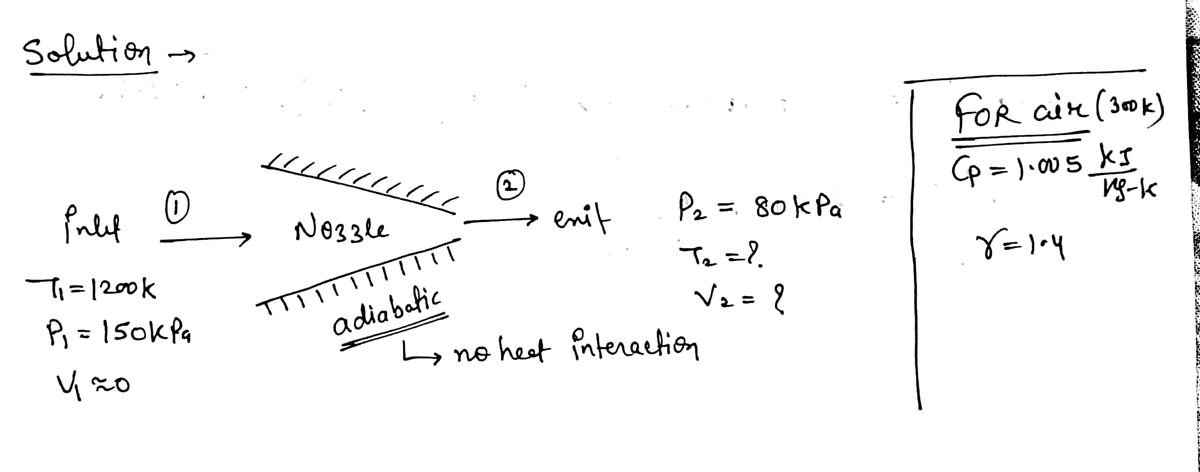Thermodynamics Please READ THE PROBLEM! I’m tired of posting the same problem over and over. please Read. This is what the asking for please: -1. sketch and label all your answers on the nozzle -2. Sketch and label all your answers on the process on a P-V diagram.... Thank you
Thermodynamics Please READ THE PROBLEM! I’m tired of posting the same problem over and over. please Read. This is what the asking for please: -1. sketch and label all your answers on the nozzle -2. Sketch and label all your answers on the process on a P-V diagram.... Thank you
Elements Of Electromagnetics
7th Edition
ISBN:9780190698614
Author:Sadiku, Matthew N. O.
Publisher:Sadiku, Matthew N. O.
ChapterMA: Math Assessment
Section: Chapter Questions
Problem 1.1MA
Related questions
Question
100%

Transcribed Image Text:### Nozzle Design and P-v Diagram Analysis
**Objective:**
- Sketch and label the nozzle.
- Sketch and label the process on a P-v (Pressure vs. Volume) diagram.
- Include all numerical values relevant to the P-v diagram.
**Problem Statement:**
7.15 The exit nozzle in a jet engine receives air at an entrance temperature and pressure of 1200 K and 150 kPa, respectively, with negligible kinetic energy. The air exits at a pressure of 80 kPa. The process is both reversible and adiabatic. Use a constant specific heat at a reference temperature of 300 K to find the exit velocity.
**Diagram Explanation:**
- **Nozzle Sketch:** The nozzle should be drawn to indicate the flow of air, labeling the inlet and exit points, showing the change in pressure from 150 kPa to 80 kPa.
- **P-v Diagram:** The diagram should display the relationship between pressure (P) and volume (v) with clear notations:
- Point 1: Initial state (1200 K, 150 kPa).
- Point 2: Final state with exit pressure of 80 kPa.
- The process will be depicted as a vertical line descending from the initial to the exit pressure, indicating a reversible adiabatic expansion.
**Analysis:**
- Assume constant specific heat at 300 K to determine the air's exit velocity using thermodynamic relations.
- The temperature and pressure differences suggest significant kinetic energy conversion, ideal for calculating aerodynamic outputs for the jet engine.
Expert Solution
Step 1

Step by step
Solved in 2 steps with 2 images

Knowledge Booster
Learn more about
Need a deep-dive on the concept behind this application? Look no further. Learn more about this topic, mechanical-engineering and related others by exploring similar questions and additional content below.Recommended textbooks for you

Elements Of Electromagnetics
Mechanical Engineering
ISBN:
9780190698614
Author:
Sadiku, Matthew N. O.
Publisher:
Oxford University Press

Mechanics of Materials (10th Edition)
Mechanical Engineering
ISBN:
9780134319650
Author:
Russell C. Hibbeler
Publisher:
PEARSON

Thermodynamics: An Engineering Approach
Mechanical Engineering
ISBN:
9781259822674
Author:
Yunus A. Cengel Dr., Michael A. Boles
Publisher:
McGraw-Hill Education

Elements Of Electromagnetics
Mechanical Engineering
ISBN:
9780190698614
Author:
Sadiku, Matthew N. O.
Publisher:
Oxford University Press

Mechanics of Materials (10th Edition)
Mechanical Engineering
ISBN:
9780134319650
Author:
Russell C. Hibbeler
Publisher:
PEARSON

Thermodynamics: An Engineering Approach
Mechanical Engineering
ISBN:
9781259822674
Author:
Yunus A. Cengel Dr., Michael A. Boles
Publisher:
McGraw-Hill Education

Control Systems Engineering
Mechanical Engineering
ISBN:
9781118170519
Author:
Norman S. Nise
Publisher:
WILEY

Mechanics of Materials (MindTap Course List)
Mechanical Engineering
ISBN:
9781337093347
Author:
Barry J. Goodno, James M. Gere
Publisher:
Cengage Learning

Engineering Mechanics: Statics
Mechanical Engineering
ISBN:
9781118807330
Author:
James L. Meriam, L. G. Kraige, J. N. Bolton
Publisher:
WILEY